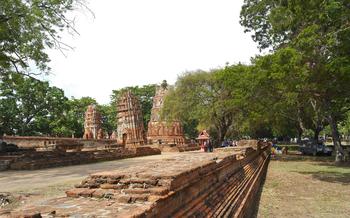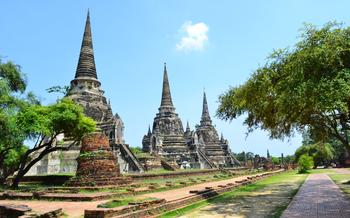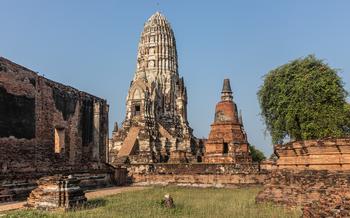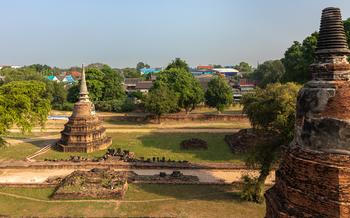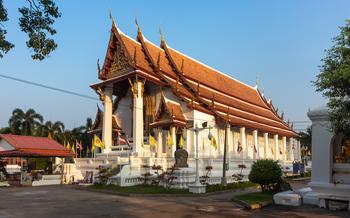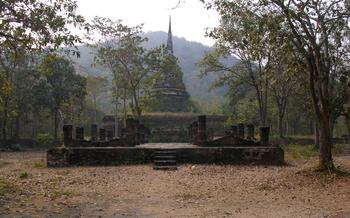
Wat Mahathat Worawihan
- History of Wat Mahathat Worawihan:
- Location and Accessibility
- Highlights of the Temple
- Exploring the Temple Grounds
- Surrounding Attractions
- Cultural Significance
- Local Cuisine
- Accommodation Options
- Unique Experiences
- Safety and Security
- Photography and Videography
- Accessibility for Visitors with Disabilities
- Insider Tip
History of Wat Mahathat Worawihan:
Wat Mahathat Worawihan, a shining beacon of Thailand's rich cultural heritage, stands as a testament to the nation's deep-rooted Buddhist traditions. Its history is intertwined with the rise and fall of empires, the ebb and flow of religious devotion, and the enduring spirit of the Thai people.
Founded in the 15th century during the Ayutthaya Kingdom, Wat Mahathat Worawihan was initially known as Wat Tham Krabok and served as a vital religious center for the local community. Over time, it underwent several renovations and expansions, each adding to its architectural splendor and religious significance.
The temple's most distinctive feature, the towering central prang, stands as a symbol of Mount Meru, the sacred abode of the Hindu gods. Its intricate carvings and delicate design showcase the exceptional craftsmanship of Ayutthaya artisans, who infused the temple with their unique artistic vision.
As the Ayutthaya Kingdom flourished, Wat Mahathat Worawihan became a prominent pilgrimage site, attracting devout Buddhists from far and wide. It housed numerous Buddha images, each revered for its unique attributes and believed to possess miraculous powers.
The temple played a pivotal role in preserving and propagating Buddhist teachings throughout the region. Monks and scholars gathered within its walls to study sacred texts, engage in philosophical debates, and impart their knowledge to future generations.
Location and Accessibility
Wat Mahathat Worawihan is conveniently situated in the heart of Phetchaburi, Thailand, a city renowned for its rich history and cultural heritage. It is easily accessible by various transportation modes, making it a popular destination for both domestic and international visitors.
Located approximately 150 kilometers southwest of Bangkok, the capital of Thailand, Phetchaburi can be reached by car, bus, or train. For those driving from Bangkok, take Highway 35 (Thanon Phetkasem) and follow the signs to Phetchaburi. The journey by car takes about 2-3 hours, depending on traffic conditions.
Alternatively, regular bus services operate from Bangkok's Southern Bus Terminal (Sai Tai Mai) to Phetchaburi. The bus journey takes approximately 3-4 hours. Once in Phetchaburi, Wat Mahathat Worawihan is within walking distance from the city center or easily accessible by local tuk-tuks or taxis.
For a more immersive experience, consider joining an organized tour from Bangkok or nearby cities. These tours typically include transportation, a guided tour of the temple, and visits to other attractions in Phetchaburi.
Whether traveling independently or with a tour group, make sure to allow ample time to explore the temple's serene grounds and appreciate its architectural wonders.
Highlights of the Temple
-
Main Prang (Central Tower): The towering main prang is the most prominent feature of Wat Mahathat Worawihan. It represents Mount Meru, the sacred mountain at the center of the Buddhist universe. Its intricate carvings and symbolic motifs depict various deities and scenes from Buddhist mythology.
-
Architectural Details: The temple's design showcases a blend of Ayutthaya and Khmer architectural styles. Look for the elegant columns, delicate stucco work, and ornate pediments that adorn the temple's exterior. The ubosot (ordination hall) and wiharn (assembly hall) feature impressive murals depicting significant events from the life of Buddha and Thai history.
-
Unique Relics: Wat Mahathat Worawihan houses several unique relics and artifacts that hold religious and historical significance. Among them is a large, ancient Buddha image known as Phra Chao Tham, which is believed to date back to the 13th century. The temple also displays a collection of ancient Khmer sculptures and artifacts, offering a glimpse into the region's rich cultural heritage.
Exploring the Temple Grounds
The layout of Wat Mahathat Worawihan is designed to inspire a sense of peace and tranquility. The temple's grounds are divided into several sections, each with its own unique significance. The heart of the complex is the ubosot, or ordination hall, where monks are ordained and important ceremonies take place. The ubosot is a large, rectangular building with a distinctive gable roof and intricate carvings adorning its exterior. Inside, visitors can admire the beautiful Buddha images and murals that decorate the walls.
Adjacent to the ubosot is the wiharn, or assembly hall, where monks gather for prayers and meditation. The wiharn is a spacious building with a high ceiling supported by massive pillars. The walls are lined with Buddha images and colorful paintings depicting scenes from the life of Buddha. Visitors are welcome to sit and meditate in the wiharn, or simply take a moment to appreciate the peaceful atmosphere.
Throughout the temple grounds, visitors will find a variety of other structures, including chedis (stupa-like structures), salas (pavilions), and bell towers. Each of these structures has its own unique purpose and contributes to the overall beauty and harmony of the temple.
When exploring the temple grounds, it's important to be respectful of the religious significance of the site. Visitors should dress modestly and avoid making loud noises or engaging in disruptive behavior. Photography is permitted, but it's important to be mindful of other visitors and avoid using flash photography inside the temple buildings. Taking the time to explore the temple grounds at a leisurely pace is the best way to appreciate its beauty and tranquility.
Surrounding Attractions
Phetchaburi offers a plethora of attractions beyond Wat Mahathat Worawihan, inviting you to delve deeper into its rich history and cultural tapestry.
-
Khao Wang Palace: Located atop a hill overlooking the city, this former royal residence boasts stunning views and intricate architectural details.
-
Phra Nakhon Khiri Historical Park: Explore the ruins of ancient palaces and temples set amidst lush greenery, offering a glimpse into Phetchaburi's past grandeur.
-
Tham Khao Luang Cave: Embark on a spelunking adventure through this extensive cave system, adorned with impressive stalactites and stalagmites.
-
Wat Yai Suwannaram Temple: Discover another significant Buddhist temple in Phetchaburi, featuring a towering golden Buddha statue and intricate murals depicting Buddhist legends.
Combine your visit to Wat Mahathat Worawihan with these nearby attractions to create a comprehensive and immersive Phetchaburi experience.
-
Plan a day trip: Allocate a full day to explore Wat Mahathat Worawihan and at least one or two other attractions, allowing ample time to appreciate each site's unique offerings.
-
Extended stay: For a more in-depth exploration, consider spending a few days in Phetchaburi, enabling you to visit additional attractions and immerse yourself in the local culture.
-
Festivals and events: Time your visit to coincide with local festivals or events, such as the annual Phetchaburi Fair, to witness vibrant cultural displays and celebrations.
Cultural Significance
Wat Mahathat Worawihan holds a profound significance in Thai culture and religious practices. It serves as a spiritual center for the local community and is deeply rooted in the history and traditions of Phetchaburi. The temple is regarded as a sacred site where devotees come to pray, offer offerings, and seek blessings. It is also a place where important Buddhist ceremonies and festivals are held throughout the year.
One of the most significant aspects of Wat Mahathat Worawihan is its role in preserving and promoting Thai Buddhist teachings. The temple houses a wealth of religious texts, artifacts, and murals that depict the life and teachings of Lord Buddha. These precious treasures provide valuable insights into the history and development of Buddhism in Thailand.
Moreover, the temple is closely associated with several legends and folklore that have been passed down through generations. These stories often revolve around the temple's origins, miraculous events, and the sacred relics enshrined within. They play an important role in shaping the cultural identity of Phetchaburi and add an air of mystery and reverence to the temple.
Wat Mahathat Worawihan's cultural significance extends beyond its religious function. It is also a testament to the artistic and architectural prowess of the Thai people. The temple's intricate carvings, stunning murals, and awe-inspiring stupas showcase the exceptional craftsmanship and creativity of Thai artisans. The temple's design and layout reflect the principles of Buddhist cosmology, symbolizing the journey towards enlightenment and the attainment of nirvana.
By visiting Wat Mahathat Worawihan, travelers can gain a deeper understanding of Thai culture, history, and religious traditions. The temple offers a glimpse into the spiritual beliefs and practices of the Thai people and serves as a reminder of the country's rich cultural heritage.
Local Cuisine
Indulge in the tantalizing flavors of Phetchaburi's culinary scene, where authentic Thai cuisine awaits. Savor the delectable Khao Soi Phetchaburi, a flavorful noodle dish prepared with coconut milk, curry paste, and tender chicken. Don't miss the opportunity to try Khanom Kluay, a sweet and sticky coconut dessert that is a local specialty. For a taste of street food, head to the bustling markets and sample Khanom Jeen, a rice noodle dish served with various curries and toppings. Remember to try Sai Krok Phetchaburi, a unique fermented sausage that is a culinary delight.
Immerse yourself in the local culture by visiting Talat Chao Samran, a vibrant market where you can find fresh ingredients, local delicacies, and cooking demonstrations. Take a cooking class to learn the art of Thai cuisine and create your own culinary masterpieces. Be sure to sample the Khanom Mor Geng, a steamed rice cake with a sweet and savory filling, which is a local favorite.
Accommodation Options
Wat Mahathat Worawihan offers a variety of accommodation options for visitors to choose from, catering to different budgets and preferences. For those seeking a budget-friendly stay, there are several guesthouses and homestays located within walking distance of the temple. These offer basic but comfortable rooms at affordable prices, allowing travelers to save on accommodation costs.
For those seeking a more luxurious experience, there are several upscale resorts and boutique hotels in the area that offer modern amenities and stunning views of the temple and the surrounding landscape. These hotels typically feature spacious rooms, private balconies, and a range of facilities such as swimming pools, spas, and restaurants.
To find the best deals on accommodation, it is advisable to book in advance, especially during peak tourist seasons. Online booking platforms and travel agents can often offer discounted rates and special promotions. It is also worth considering staying for multiple nights to fully immerse yourself in the temple's atmosphere and explore the surrounding area at a leisurely pace.
Unique Experiences
Wat Mahathat Worawihan offers a unique opportunity to delve deeper into Thai culture and spirituality. Visitors can participate in meditation sessions or spiritual retreats conducted by the resident monks. These sessions provide a chance to learn about Buddhist teachings, practice mindfulness, and find inner peace amidst the serene atmosphere of the temple.
For a truly immersive experience, visitors can also take part in traditional Thai ceremonies and events held at the temple. These ceremonies showcase the rich cultural heritage of Thailand and offer a glimpse into the daily lives of the local people. One of the most popular ceremonies is the alms-giving ceremony, where visitors can offer food to the monks as a symbol of respect and generosity.
For those seeking a more in-depth understanding of Buddhism, the temple also offers opportunities to interact with local monks and learn about their way of life. Visitors can engage in conversations with the monks, ask questions about their beliefs and practices, and gain insights into the teachings of the Buddha.
Finally, to capture the essence of the temple's beauty and tranquility, visitors can visit during sunrise or sunset. As the golden rays of the sun illuminate the temple's spires and cast long shadows across the grounds, a sense of awe and serenity envelops the atmosphere. This is an ideal time for photography enthusiasts to capture stunning shots of the temple against the backdrop of the sky.
Safety and Security
Wat Mahathat Worawihan is generally a safe place to visit, but it's important to take precautions to ensure a trouble-free experience. As with any travel destination, be aware of your surroundings and keep valuables secure. Avoid walking alone at night and be mindful of pickpockets in crowded areas. Respect local customs and avoid disrespectful behavior, such as loud talking or pointing your feet at Buddha images. Follow the dress code guidelines and remove your shoes before entering sacred spaces. Be cautious when climbing steep stairs or exploring dimly lit areas. If you have any concerns or need assistance, don't hesitate to approach a temple staff member or local authority.
Photography and Videography
Respect the Sacred Space: When capturing the beauty of Wat Mahathat Worawihan through photography or videography, it's essential to be mindful of the sacred nature of the temple. Respect the privacy of other visitors and avoid disruptive behavior that may disturb their spiritual experience.
Capture the Essence: To capture the essence of the temple's architecture and surroundings, consider using a wide-angle lens to showcase the grandeur of the structures. Experiment with different angles and perspectives to create unique and captivating shots.
Respectful Approach: Remember that the temple is a place of worship, so be respectful when taking photos or videos. Avoid using flash photography inside the temple's sacred spaces, as it may be disruptive to religious ceremonies or meditation practices.
Observe Restrictions: Be aware of any restrictions or fees associated with photography or videography within the temple complex. Some areas may be designated as off-limits for photography, so it's important to follow the guidelines and signage posted throughout the temple grounds.
Accessibility for Visitors with Disabilities
- Information on accessibility features available at the temple, such as ramps or wheelchair access:
Currently, there is limited information available regarding specific accessibility features at Wat Mahathat Worawihan. It is recommended to contact the temple authorities or local tourism offices in advance to inquire about accessibility options.
- Recommendations for visitors with mobility challenges or other disabilities:
Visitors with mobility challenges or other disabilities may find it helpful to plan their visit in advance. It is advisable to inform the temple authorities or tour operators about any specific needs or requirements. Additionally, visitors can consider bringing a companion or travel assistant to provide support and assistance during their visit.
- Tips for navigating the temple grounds and ensuring a comfortable visit:
The temple grounds are generally well-maintained, with paved pathways and relatively level surfaces. However, some areas may have steps or uneven terrain, making it challenging for wheelchair users or individuals with limited mobility. It is recommended to take breaks and rest as needed, and to avoid visiting during peak hours to minimize crowds.
- Mention any assistive services or resources that may be available:
At this time, there is no specific information available regarding assistive services or resources specifically provided by Wat Mahathat Worawihan. Visitors with disabilities are encouraged to contact the temple authorities or local tourism offices to inquire about any available options or accommodations.
Insider Tip
For a truly unique experience, make sure to visit Wat Mahathat Worawihan during the annual temple fair, usually held in November. This vibrant festival features colorful processions, traditional performances, and a lively market filled with delicious street food and local handicrafts. It's a fantastic opportunity to immerse yourself in Thai culture and witness the temple come alive with joyous celebrations.
One hidden gem within the temple complex is the small meditation garden located behind the main prang. This serene space offers a tranquil escape from the hustle and bustle of the temple grounds. Take a moment to sit in silence, surrounded by lush greenery and the gentle sound of flowing water, and let the peaceful atmosphere wash away your worries.
For photography enthusiasts, capturing the temple's beauty at sunrise or sunset is a must. The golden hues of the rising or setting sun cast a magical glow on the temple's spires and create stunning photo opportunities. Be sure to arrive early or stay late to witness this enchanting spectacle.
My personal anecdote with Wat Mahathat Worawihan involves a chance encounter with a local monk who shared fascinating stories about the temple's history and significance. His insights and teachings left a lasting impression on me, deepening my appreciation for the temple's spiritual and cultural importance.
